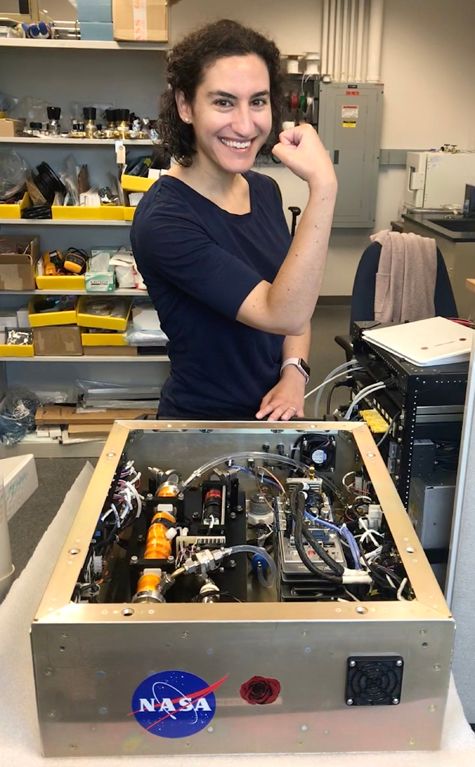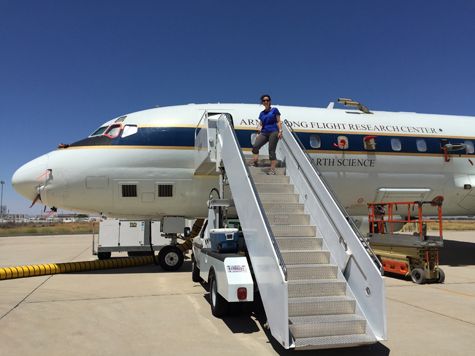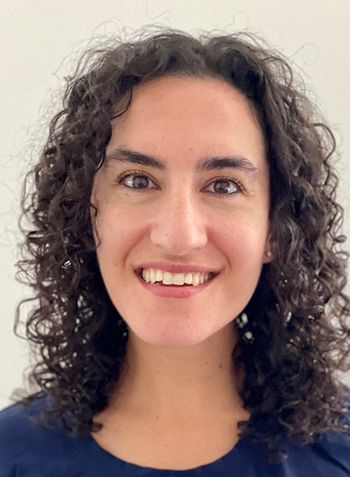Early Career Scientist Spotlight
Dr. Reem Hannun (she/her)
Atmospheric Chemist
Atmospheric Chemistry and Dynamics Laboratory (614)
What is your research focus?
My research in atmospheric chemistry broadly focuses on understanding the life cycle of trace gases in the atmosphere. In other words, I’m interested in trying to identify the sources, chemical evolution, and fates of species like greenhouse gases, oxidants, and pollutants, which influence both air quality and Earth’s climate. As an experimentalist, I help build highly sensitive instruments that are typically flown aboard NASA research aircraft to make measurements of atmospheric composition around the globe. I’ve deployed instruments to measure gases such as CO2 (carbon dioxide), CH4 (methane), CH2O (formaldehyde), NO2 (nitrogen dioxide), and O3 (ozone).
I am especially interested in questions that integrate atmospheric chemistry with the greater Earth system. For example, the Earth’s biosphere plays a significant role in exchanging several trace gases with the atmosphere. These exchange processes, like uptake and emissions by soils and vegetation, help mediate the atmospheric abundance of both greenhouse gases and more reactive gases like O3. The instruments we’ve deployed are actually sensitive enough to measure trace gas exchange rates. I have been working within the NASA Carbon Monitoring Systems program to directly quantify CO2 and CH4 exchange with measurements from a low-flying aircraft. Currently, I am using these data to better understand the biogenic processes that control the uptake of CO2 by biomass in forested regions as well as the drivers of CH4 emissions in wetland ecosystems.

Credit: Paul Newman
What is one research project that you are particularly excited about, and why?
One project I’m particularly excited about has been the development of a new ozone (O3) instrument capable of measuring O3 exchange with the Earth’s surface. In the stratosphere, the O3 layer absorbs solar UV, shielding the surface from harmful radiation. In the lower atmosphere; however, O3 is a component of photochemical pollution and a potent oxidizing agent that damages human and plant life, with negative consequences for respiratory health, crop growth, and ecosystem productivity. The loss of tropospheric O3 due to deposition on surfaces remains an outstanding source of uncertainty in modeling the fate of O3. I recently helped build the Rapid Ozone Experiment (ROZE) a new O3 instrument based on a cavity-enhanced UV absorption technique that has the sampling speed and precision to make these measurements. To date, ROZE has already flown on the NASA DC-8 and ER-2 aircraft and has made high-precision measurements of O3 throughout the troposphere and lower stratosphere. I hope to continue using the ROZE instrument to collect more comprehensive measurements of O3 loss to vegetation and other surfaces.
What do you enjoy the most about your job?
I consider doing fieldwork one of the highlights of my job. Atmospheric chemistry has a rich collection of modeling and remote sensing tools, but data on the ground (or in the air) is essential to validate our current understanding of the system. With such important implications for global-scale problems like air quality and climate, atmospheric chemistry really demands observation-backed results, especially when informing policy decisions.
Fieldwork is also a nice change of pace from daily life in the lab or office, and it’s really satisfying to see an instrument you’ve worked so hard on go out and collect real measurements. Some of the field campaigns I’ve been involved with while at NASA include the Carbon Airborne Flux Experiment (CARAFE), which measured carbon exchange from different ecosystems in the Mid-Atlantic region; the Atmospheric Tomography Mission (AToM), which profiled atmospheric composition and chemistry over the remote ocean regions; Fire Influence on Regional to Global Environments and Air Quality (FIREX-AQ), which studied the chemical evolution of fire smoke plumes; and Dynamics and Chemistry of the Summer Stratosphere (DCOTSS), a campaign to assess the impact of convective storm systems on the stratosphere over North America.

Credit: Jason St. Clair
What skills are most useful to you in your work, and where did you develop those skills?
Being an experimental atmospheric chemist requires a hodge-podge of skills. For example, putting together an instrument requires some basic mechanical skills, as well as some knowledge of electronics, optics, and software engineering. Data analysis requires its own skillset, including proficiency with coding, computational tools, and handling large datasets. I started picking up these skills as a graduate student, where I spent a lot of my time playing around with various instruments in the lab. Mostly, I am still learning as I go, thanks to the good fortune of having patient colleagues and mentors. I enjoy the variety of skills needed to do my work, which prevents it from getting boring.
What are your future research interests and goals?
I recently started a research-track faculty position at the University of Pittsburgh, where my husband and I relocated mid-pandemic to solve a two-body problem that became a four-body problem when we had kids. I still maintain an affiliation with NASA GSFC, but my current job is kind of an unusual hybrid of academic and non-academic. At the University, the department places a big focus on education, which keeps me mindful of the big-picture impact of the work I do. Aside from continuing to develop my own research, one of my future goals is to learn how to successfully mentor and support students, especially women, who are interested in atmospheric research and fieldwork. I have personally benefitted from the great mentors I had while at NASA, so I’m hoping to pay that forward.
Did you always know that you wanted to be an atmospheric chemist?
No, definitely not, but I have always loved the Earth sciences. I grew up by the ocean and remember reading a lot about marine biology as a kid. I also quickly learned I’m very prone to sea sickness, so I gave up seriously thinking of that as a career path. I really enjoyed my physics and chemistry courses throughout high school and ended up majoring in physical chemistry in college. I was specifically intrigued by the field of spectroscopy because of the way light-matter interactions enabled us to “see” the otherwise invisible. But I knew I wanted to pursue an area of research that tied these abstract concepts to more human-scale problems. After college, I spent a year as a research assistant in an atmospheric chemistry lab that used spectroscopy to make measurements of the atmosphere. I found the work so interesting that I decided to apply to stay on as a graduate student. I became even more involved in fieldwork as a postdoc at NASA. Ironically, I am also very prone to airsickness, and the field portion of my job often involves flying around in turbulence!

Credit: Reem Hannun
What do you like to do in your free time?
As a new mom of twins, I spend my free time these days quite differently than I used to. Although I’ve had to cut back on some of the hobbies I previously enjoyed (hiking, baking, traveling, having quiet time to read) it’s been a different kind of adventure getting to share new experiences with my two kids. It has also been an interesting and often hectic experiment (one still in progress) to find the right balance between being an attentive parent and focusing on my work.
Biography
Home Town:
Charleston, SC
Undergraduate Degree:
BA in Chemistry, Dartmouth College, Hanover, NH
Post-graduate Degree:
PhD in Chemistry, Harvard University, Cambridge, MA

